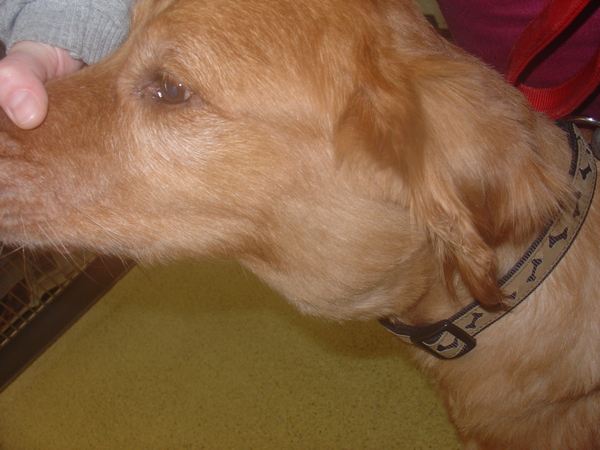Lymphoma in dogs
Lymphoma is a common type of canine cancer, especially in middle-aged dogs. It can present in various ways, but the most common symptom is enlarged lymph glands. It is usually treated with chemotherapy.
Key takeaways
- Lymphoma is a common type of cancer in dogs, and the main sign is enlarged lymph nodes.
- Chemotherapy is the standard treatment, typically putting the cancer into remission and extending the dog's life.
- Without treatment, dogs with lymphoma generally survive only 4-6 weeks.
- There's no known prevention for lymphoma in dogs, and euthanasia may be considered in the final stages to reduce suffering.
 What is lymphoma in dogs?
What is lymphoma in dogs?
Lymphoma is a type of cancer, specifically, a cancer affecting lymphocytes, a type of white blood cell. Lymphocytes travel around the body, fighting infection and disease. Lymphoma affects certain sites in a dog’s body: most commonly the lymph glands (also called lymph nodes), but also the liver, spleen, bone marrow, kidneys, skin, thymus and digestive system. There are a few different types of lymphoma that affect dogs.
What causes lymphoma in dogs?
Cancers usually occur due to malignant defects in cells. Scientists are unsure of the exact cause or causes of lymphoma, but genetics may play a role. External influences, such as viruses, bacteria, or certain chemicals, may also cause mutations in the lymphocyte cells.
Symptoms of lymphoma in dogs
There are various symptoms, depending on the type of lymphoma and how aggressive it is.
The most common symptom is enlarged lymph nodes. These glands are found under the jaw, in front of the shoulder, behind the knees, in the armpits and in the groin area. Usually, lymph nodes are very small and difficult to feel, but in dogs with lymphoma, they can swell into large, solid lumps.

Image of swollen lymph nodes on 12 year old Golden Retreiver. © Joel Mills. Photo by Joel Mills. Source
Other signs of lymphoma can include:
- Lethargy
- Reduced appetite
- Drinking and urinating more
- Vomiting and diarrhoea
- Weight loss
- Crusty, sore skin
- Pale and/or yellow gums
- Breathing problems or coughing
What are the stages of lymphoma in dogs?
If your dog shows any of the above signs, it is recommended to take them to a vet for a health assessment. Lymphoma is generally diagnosed via a biopsy sample from a lump, lesion or nodule.
Your vet may also perform other tests, such as blood tests, urine samples, skin tests, X-rays, and ultrasound. These tests are useful not only for the initial diagnosis but also to grade and stage the lymphoma. Classifying the lymphoma allows for more specific treatment plans and better estimates of survival, so it’s important to gather as much information about this cancer as possible.
The grading system shows how aggressive the type of lymphoma is, whereas the staging system shows how much it has spread.
Stage I
Only a single lymph node affected.
Stage II
Involves lymph nodes on only one side of the diaphragm (affects the front of the body OR the rear of the body but not both).
Stage III
Lymph nodes all across the body are affected.
Stage IV
Involves the liver and/or the spleen.
Stage V
Involves the bone marrow, nervous system or other rare location.
Treatment for lymphoma in dogs
Without any treatment, the vast majority of cases of lymphoma are sadly fatal in just a few weeks. However, there are options for various treatment protocols.
Chemotherapy
The most common treatment for all types of lymphoma is chemotherapy. These drugs target the cancerous cells and destroy them. However, sadly, chemotherapy is not a complete cure; the aim is to increase quality of life, prolong life expectancy, and achieve remission (when the cancer is not completely gone but is indetectable and there is a temporary resolution of symptoms).
Most chemotherapy protocols for canine lymphoma involve a mixture of drugs. This may mean some tablets and some injectable medication. It usually involves fairly frequent vet visits and blood tests, which can be difficult for some patients. However, the side effects of chemotherapy in animals are much less than in humans.
Chemotherapy can prolong survival rates to around 6 - 12 months.
Other treatments
Some types of lymphoma may require surgical removal of the spleen. Radiation therapy is also occasionally used to treat certain lymphomas.
What is the life expectancy of dogs with lymphoma
Lymphoma has a variable prognosis, depending on its grade and stage. However, in dogs diagnosed with lymphoma who do not undergo treatment or are treated palliatively with corticosteroid medication only have an average life expectancy of only 4 - 6 weeks. This survival rate is increased with chemotherapy to around 6-12 months. Sadly, most dogs with lymphoma will eventually lose their quality of life as they stop responding to treatment or their condition progresses, and often, euthanasia will be needed to prevent suffering.
FAQs
How can you prevent lymphoma in dogs?
Unfortunately, there is no known way to prevent lymphoma in dogs.
What are the final stages of lymphoma in dogs?
Depending on the type of lymphoma, dogs in the final stages of the disease may become very unwell. Signs may include severe weight loss, gastrointestinal symptoms such as vomiting and diarrhoea, kidney and liver failure, breathing difficulties and weakness.
Will a dog with lymphoma die naturally?
Although dogs with lymphoma will eventually die naturally, the final stages of lymphoma can involve much pain and suffering. It is often kinder to consider euthanasia before a pet loses all quality of life and begins to suffer pain and distress.

Need more info?
For more advice on lymphoma, have a chat with your local vet.
Find your nearest vet using our find a vet page, or speak to a vet online using our team of experienced video vets.

